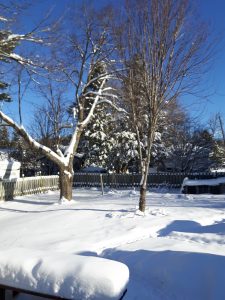
Hi,
I have a large tree that during the extreme cold showed a large crack in the trunk. Should it be strapped? Is it in danger of splitting?
We live near North Bay, Ontario.
This post will deal with your first question; some thoughts re your question about pruning your shrub will follow.
Extremely cold winter temperatures can cause these splits, known as frost cracks, which can extend deeply into the wood of the tree’s trunk. These cracks usually occur on the south or west side of trees when their bark and inner layers are warmed by the sun, causing these layers to expand. When temperatures drop at the end of the day, contraction occurs, with the wood closest to the surface shrinking quickly while the interior layers take longer to contract. It is this unequal shrinkage that creates pressure, causing the wood to crack.
In summer, sometimes these cracks will expand and close, or partially close, of their own accord. Often a raised area of “callus tissue” will develop in the tree’s attempt to close the wound. However, even a slight opening may be enough to allow insect pests and fungal diseases to infest or infect the tree. The best defense here is to use good gardening cultural practices to ensure your tree is the healthiest it can be: make sure you water your tree during drought conditions, avoid compacting the soil around it, remove leaf debris in the fall, and amend your soil with organic fertilizers and mulch (not touching the base of the trunk but in a circle around it).
If you can tell as you head into summer that your tree is not thriving, it may make best sense to have an arborist look at it. The Ontario chapter of the International Society of Arboriculture’s website can help you to locate a qualified arborist in your area: https://www.isaontario.com/ An arborist can help you determine whether strapping or cabling your tree is a viable option. I assume the tree you are referring to is the large tree with the V-shaped crotch in your photo. These V-shapes are often a feature of fast growing trees, and they may cause the tree to split apart, especially if there is any internal decay which may not be visible to you. It can be difficult for a home gardener to diagnose and repair injuries in mature trees, which is why an arborist’s advice can be useful in these circumstances

